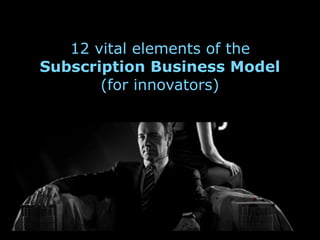
12 Vital elements of the Subscription Business Model
- 1. 12 vital elements of the Subscription Business Model (for innovators)
- 2. From Simon+Kucher Consumer Insights magazine, spring 2016 (pdf) The subscription business model delivery products & services on a subscription basis. And it has found its way into everything we daily consume.
- 3. Customer Business 1 Access to intangible assets: software, media,TV shows, music, movies, ebooks, magazines, video,TV shows, games, Software as a Service (SaaS) 2 Access to durable goods: cars, bicycle, smartphones (with contracts) 3 Regular delivery of goods: newspapers, clothing, toiletry, consumer packaged goods and any other consumer goods 4 Utilities: internet, phone contract, electricity, computing power, Infrastructure as a Service (IaaS). Note, many utilities providers use a combination of subscription business model and pay-per-use 1 1 1 Regular delivery of goods & services for recurring payment
- 4. (1) Value & quality (2) Clear offers & fair pricing (3) Convenient transactions (4) Improve offer continuously (5) Localise offering (6) Personalise (7) Build a culture of membership (8) Make deeper connections (9) Freemium to get started (10) The right metrics (11) Funding sources (12) Cost structure 12 Vital Elements of the Subscription Business Model
- 5. (1) Provide value and quality - Refrain from (purely) regurgitating the same-old - Add exciting, industry-leading, price-winning exclusive flagship offers - Amend your flagship offers with the same-old Netflix: from DVD / streaming provider to producer of their own exclusive shows
- 6. (2) Clear offer & fair pricing - Make clear offers - Avoid options-overkill (typically 3) - Make the different pricing clear & fair
- 7. Foxtel (AU): - 26 options —> overkill - Disingenuous disaggregation of channels - Massive price gap between entry and full package $26-$137 - Lock-in contracts: previously acceptable, now obsoleting
- 8. Netflix: - 3 options only - Differences are clear to understand - Transparent and fair price range ($9-$15)
- 9. (3) Offer convenient transactions (example: Dollar Shave Club) - Easy payment - Any time: cancellation, upgrade, downgrade - Skipping of month https://www.dollarshaveclub.com/how-it-works
- 10. 1 Exclusively shows (Amazon Prime TV) 2 Monthly “What’s new” MS-Office 3 Varying recipes on food subscriptions (4) Improve your offering continuously: - From big-bang product roll-outs to continuous evolution - This has impact on your R&D roadmap and processes
- 11. (5) Localise your offering - One size does (no longer) fit all - More relevant offerings “Narcos told Brazilians that Netflix is paying attention to Brazil and paying attention to talent we have here. It’s also elevating local talent to the world.” https://www.bloomberg.com/news/ features/2017-01-12/netflix-wants- the-world-to-binge-watch
- 12. (6) Personalise - Create personalisable elements in your offering - Higher customer engagement - Soft switching barriers myFT let’s you personalise what you are interested in
- 13. (7) Build a culture of membership - Increases direct network effects - Increase loyalty & customer lifetime value
- 14. (8) Make deeper connections through values alignment - Ambitious goal - bigger than profit making - Deeper connection with customers - No longer competing on price only Blue Apron aims to build a better food system which.These foods are then used in their subscription model recipes and food delivery
- 15. (9) Freemium: get started! - As a means of trial - To create a networked effect - To serve as a marketing channel Spotify: Freemium vs Premium
- 16. (10) Measure the right metrics - Future recurring costs & revenues - Customer lifetime value & Churn http://www.slideshare.net/Zuora/zuora-always-on20123-saas-metrics-that-matter-12301579
- 17. (11) Funding sources - Anticipate the moves of incumbents - Expect imitators - Have funding sources (cost of capital) Spotify’s long slog to not-yet-profitability
- 18. (12) Cost structure - Distribution, transaction costs, asset management, etc - Sourcing / supply chain, infrastructure - Differences/benefits to ownership offering With reliable low-cost distribution at no increased piracy risk, monthly subscriptions pricing models were introduced • Distribution: low cost via fast-speed, broadband internet • Transactions: Direct business to consumer (intermediaries eliminated) • Asset management: direct licence, piracy control, regular updates Consumption-based pricing was the legacy pricing model for utilities enabled by • Distribution: low cost via government-funded infrastructure • Transactions: business to consumer (if privatised) • Asset management: consumer-owned assets are to be purchased (e.g. handheld, metering) With location-specific, wireless technologies, the pricing model could be extended to mobile physical goods, incl cars • Distribution: low cost (compared to car rental); location-specific • Transactions: mobile, real- time, business to consumer • Asset management: GPS, wireless, security, user accountability Utilities Software Car sharing
- 19. Amazon Prime is probably the biggest subscription business model on earth and it just got another major boost …
- 20. The subscription business model is one of the most promising business models regardless if you work for an established company or a young one. We have free downloads for you to develop your own innovation ideas Click here to download: www.InnovationTactics.com/ subscription-business-model-pdf
